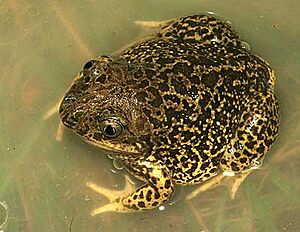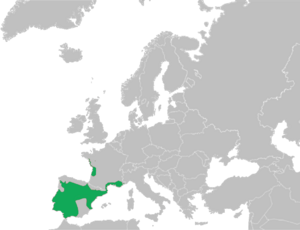Pelobates cultripes facts for kids
Quick facts for kids Pelobates cultripes |
|
|---|---|
 |
|
| Pelobates cultripes | |
| Conservation status | |
| Scientific classification | |
| Genus: |
Pelobates
|
| Species: |
cultripes
|
 |
|
| The approximate distribution of Pelobates cultripes | |
| Synonyms | |
|
|
Pelobates cultripes is a special kind of toad. It belongs to the Pelobatidae family. People call it by many names, like the western spadefoot or Spanish spadefoot toad. You can find this toad mostly in the countries of Spain and Portugal. There are also some groups in southern and western France.
Contents
What Does It Look Like?
The western spadefoot is a large toad. It has smooth skin and shiny gold or green eyes. Its pupil (the black part in the middle of the eye) is shaped like a line, not round.
This toad gets its name from a special black "spade" on its back foot. This spade helps it dig into the ground very quickly. Its top side is usually yellowish-grey. It has dark brown or green spots and patches.
Western spadefoot toads can grow up to 11 centimeters (about 4.3 inches) long. They are usually bigger and greener than the common spadefoot toad. Even their tadpoles are larger than those of most other toad species.
Daily Life and Habits
This toad is mostly nocturnal (active at night). But sometimes, after it rains, you might see many of them during the day. They like to hide in burrows they dig. These burrows can be as deep as 20 centimeters (about 8 inches).
If a western spadefoot feels threatened, it will puff up its body. It also makes a soft, kitten-like sound.
Life Cycle
Western spadefoot toads often breed in temporary water puddles. Sometimes, this water can be a little brackish (salty). When it's time to mate, the male toads arrive first at the breeding spots on wet nights. The females come later.
The breeding time depends on how much rain falls. It can last for a whole month or just a few days. During this time, the toads might be partly active during the day. The male toad holds onto the female's loins (lower back).
Females lay long strings of eggs, up to 100 centimeters (about 39 inches) long. Each string can have up to 7,000 eggs! They lay these eggs among plants or on the bottom of the pond. The eggs hatch after about two weeks. The tadpoles then take about 4 to 6 months to grow into young toads.
The biggest danger for tadpoles, after being eaten, is their pond drying up. Young toads are about 2 to 3.5 centimeters (0.8 to 1.4 inches) long after they change from tadpoles. They become adults and can have their own babies after about three years. These toads can live for up to 15 years!
Male toads make a deep, fast "co-co-co" sound underwater. It sounds a bit like a clucking hen. Female toads also make calls sometimes.
Where Do They Live?
You can find this toad mostly in Portugal, Spain, and some parts of France. Its home area does not overlap with the common spadefoot toad.
Western spadefoot toads like open areas. They prefer soft or sandy soils. You can find them living at high places, up to 1,800 meters (about 5,900 feet) above sea level.
Images for kids






